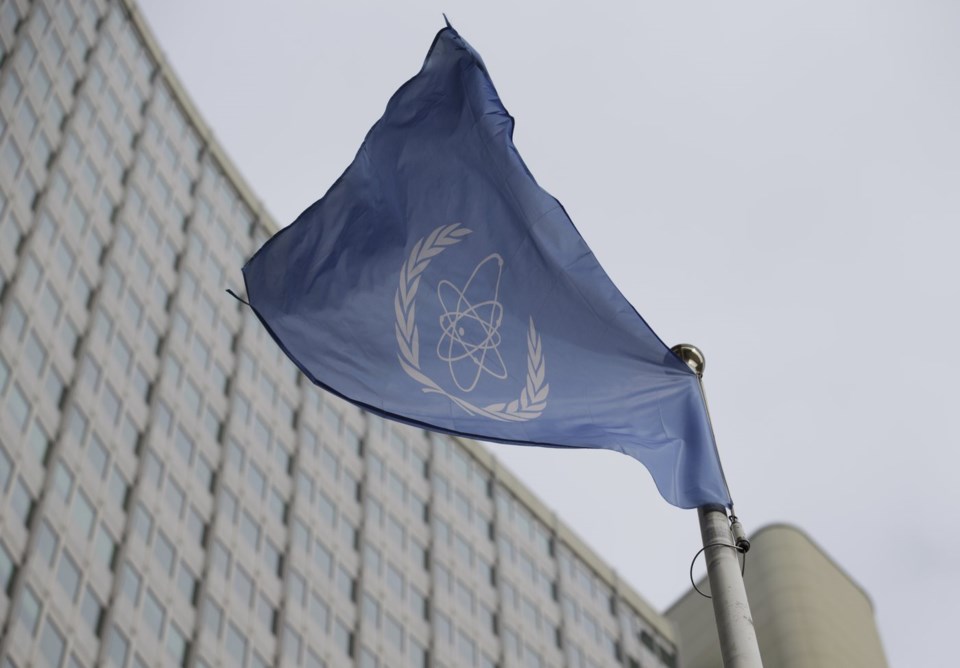VIENNA (AP) — Iran has further increased its stockpile of uranium enriched to near weapons-grade levels in defiance of international demands, a confidential report by the United Nations’ nuclear watchdog said Thursday.
The , seen by The Associated Press, said that as of Aug. 17, Iran has 164.7 kilograms (363.1 pounds) of uranium enriched up to 60 %. That's an increase of 22.6 kilograms (49.8 pounds) since the IAEA's last report in May.
Uranium enriched up to 60% purity is just a short, technical step away from weapons-grade levels of 90%. By IAEA’s definition, around 42 kilograms (92.5 pounds) of uranium enriched to 60% is the amount at which creating one atomic weapon is theoretically possible — if the material is enriched further, to 90%.
The IAEA chief, that Tehran has enough uranium enriched to near-weapons-grade levels if it chose to do so. He has acknowledged the U.N. agency cannot guarantee that none of .
Thursday's report is the latest low in spiraling relations between Tehran and the IAEA. It follows a by the 35-member IAEA Board of Governors that censured Iran for failing to cooperate fully with the Vienna-based agency.
Iran's mission at the United Nations in New York did not immediately respond to a request from the AP for comment. There were also no immediate comments from Tehran on the IAEA report.
Iran’s 2015 landmark nuclear deal with world powers had put limits on its nuclear program — which the West fears could be used for making nuclear weapons and Tehran insists is only for peaceful purposes — while lifting punitive economic sanctions imposed on Iran.
But the deal collapsed after the Trump administration in 2018 pulled the United States out of the agreement, leading Iran to abandon all limits the deal had put on its program, and enrich uranium to up to 60% purity.
Meanwhile, surveillance cameras installed by the IAEA have also been disrupted and Iran has barred some of the . Iranian officials also have increasingly threatened that they could pursue atomic weapons.
The IAEA report further says that Tehran has also not reconsidered its September decision to ban the agency's inspectors from monitoring its nuclear program and that IAEA surveillance cameras remain disrupted.
The IAEA said it had requested an Aug. 8 letter that Iran provide access to a centrifuge manufacturing site in the city of Isfahan, to enable the agency to service its cameras, but received no reply.
Additionally, the report says Iran has still not provided answers to the nuclear watchdog’s years-long investigation about the origin and current location of man-made uranium particles found at two locations that Tehran has failed to declare as potential nuclear sites, known as Varamin and Turquzabad.
The to renewed negotiations with the United States over his country’s , declaring there was “no harm” in engaging with the “enemy.”
Ayatollah Ali Khamenei’s remarks on Tuesday set clear red lines for any talks taking place under the new government of reformist and reiterated his warnings that Washington was not to be trusted.
The IAEA report said that as of Aug. 17, Iran’s overall stockpile of enriched uranium stood at 5,751.8 kilograms (12,681 pounds).
“The continued production and accumulation of high enriched uranium by Iran, the only non-nuclear weapon state to do so, adds to the agency's concern,” it concluded.
The report acknowledged that before the June elections in Iran, the IAEA was told "that further engagement with the agency would be determined by the new government.”
After Pezeshkian's win, the IAEA congratulated him and offered to send the agency's chief to Tehran "to re-launch the dialogue and cooperation between the agency and Iran,” the report said. But while the newly elected Iranian president confirmed “his agreement to meet” with the IAEA chief, nothing has moved forward on this since.
The IAEA report also said the agency verified that Tehran had completed the installing of eight cascades of IR-6 centrifuges at its underground plant at Fordo. Those additional eight cascades are not operational yet, meaning they are not yet enriching uranium.
Also, Iran has completed the installation of 10 out of 18 planned cascades of IR-2m centrifuges at the underground site in Natanz, and the installation of another two cascades was ongoing there, it said. At the same site, Iran has increased the number of operating cascades of IR-2m centrifuges by six to a total of 15, and cascades of IR-4 centrifuges by nine to a total of 12.
Under the 2015 deal, Iran was allowed to install just first-generation centrifuges. The more advanced model of centrifuges enrich uranium at a much faster pace than the baseline IR-1 centrifuges.
The IAEA report is likely to add to the wider Middle East concerns, with tensions between Iran and Israel hitting a new high since the Hamas Oct. 7 attack on Israel and the outbreak of the Israel-Hamas war in the Gaza Strip.
Tehran launched an unprecedented in April after years of a shadow war between the two countries reached a climax with Israel’s apparent attack on that killed two Iranian generals and others. The also prompted Iran to threaten to retaliate against Israel.
Stephanie Liechtenstein, The Associated Press




